Brain DiseasesYour brain serves as the body's command center. It regulates your voice, gestures, memories, and thoughts. Numerous organs' operations are controlled by it. It is a component of your nervous system, which also consists of the spinal cord and limber nerves. The nervous system transmits messages between your brain and the rest of your body. Information from your senses is gathered by your nerves and sent to the brain for processing. Your brain and nerves also work together to aid in movement and regulate bodily processes. Your brain is affected by a wide variety of ailments and conditions. They can change a person's behavior, personality, and capacity for thought and function. Numerous brain disorders affect a person's ability to do everyday tasks. There are several causes of neurological disorders. As an example:
Many causes concussions:
The most common brain diseases are mentioned below: 1. Alzheimer Disease60-70% of dementia cases are caused by Alzheimer's disease (AD), a neurodegenerative condition that typically develops slowly and becomes worse with time. Having trouble remembering recent events is the most prevalent early sign. As the condition worsens, symptoms may include behavioral problems, linguistic difficulties, disorientation (including a tendency to get lost easily), mood swings, a lack of motivation, and self-neglect. As a person's health worsens, they often become more isolated from their loved ones and society. Body functions deteriorate with time, eventually causing death. Despite the fact that the rate of advancement might vary, the usual life expectancy after diagnosis is three to nine years. Alzheimer's disease's etiology is not well known. Several genetic and environmental risk factors influence its growth. An APOE allele is the most potent genetic risk factor. Clinical depression, high blood pressure, and a history of head trauma are additional risk factors. Amyloid plaques, neurofibrillary tangles, and a loss of neuronal connections in the brain are the primary disease-related factors. A likely diagnosis is made using the patient's medical history, cognitive testing, and blood tests to rule out any other potential reasons. Initial signs are often misdiagnosed as aging of the brain. A definitive diagnosis requires an examination of the brain's tissue, which can only be done after someone has passed away. In general, good diet, exercise, and social interaction are known to improve aging, and they may also help lower the risk of cognitive decline and Alzheimer's disease. 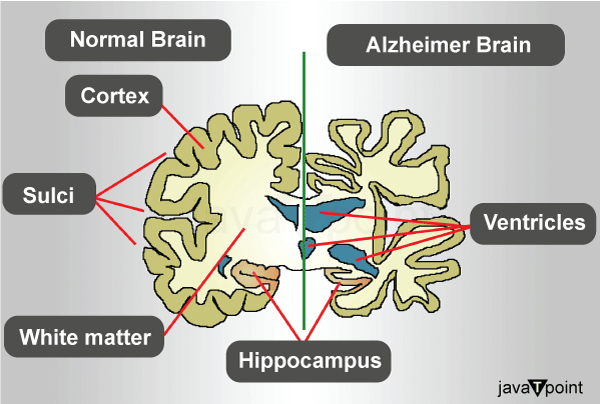
No medication can halt or reverse the disease's course; however, some may momentarily lessen symptoms. Affected individuals need more and more on others for help, which is frequently difficult for carers. Social, psychological, bodily, and economic stresses are all possible. Exercise regimens might be advantageous in everyday activities and could lead to better results. Antipsychotics are often used to treat behavioral issues or psychosis brought on by dementia. However, this is seldom advised since there is little benefit and a higher chance of dying young. Globally, there will be around 50 million individuals living with Alzheimer's disease by 2020. Although up to 10% of cases have an early beginning and affect persons in their 30s to mid-60s, it most often affects those over 65. Women are more often affected than males, affecting roughly 6% of adults 65 and older. The illness bears Alois Alzheimer's name after the German pathologist and psychiatrist who originally identified it in 1906. With an estimated yearly worldwide cost of US$1 trillion, Alzheimer's disease imposes a significant financial burden on society. It is the sixth most common cause of death in the United States. 2. Brain TumoursWhen abnormal cells develop inside the brain, a tumor is created. Malignant tumors and benign (non-cancerous) tumors are the two primary categories of tumors. These may also be divided into primary tumors, originating within the brain, and secondary tumors, which often spread from tumors outside the brain and are referred to as brain metastasis tumors. Depending on the tumor's size and the section of the brain it affects, all brain tumors may cause various symptoms. Where symptoms are present, they may include vomiting, headaches, seizures, eyesight issues, and mental changes. Other signs could include the inability to talk or move, feelings, or unconsciousness. Although up to 4% of brain malignancies may be brought on by CT scan radiation, most brain tumors have no known cause. The Epstein-Barr virus, ionizing radiation, exposure to vinyl chloride, and genetic diseases such as neurofibromatosis, tuberous sclerosis, and von Hippel-Lindau disease are uncommon risk factors. Studies on the use of mobile phones have not clearly shown a danger. Adults are more likely to develop meningiomas, which are often benign, and astrocytomas like glioblastomas. The most typical kind in youngsters is a malignant medulloblastoma. A medical examination is typically used to diagnose, combined with computed tomography (CT) or magnetic resonance imaging (MRI). A biopsy is then often used to confirm the outcome. The tumors are classified into various severity levels based on the results. Treatment may involve a mix of surgery, radiation treatment, and chemotherapy. If seizures occur, anticonvulsant medication may be required. Dexamethasone and furosemide are two drugs that may be used to reduce edoema around the tumor. 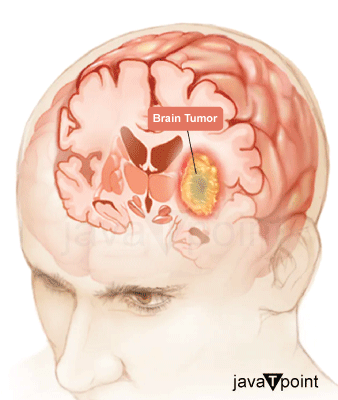
Some tumors develop gradually, requiring just observation and no additional treatment. Treatments that rely on a person's immune system are being researched. The prognosis for malignant tumors varies greatly depending on the kind of tumor and how far it has gone at the time of diagnosis. Although benign tumors only develop in one site, they may be fatal depending on their size and location. Malignant glioblastomas normally have extremely bad results, but benign meningiomas frequently have favorable outcomes. The average five-year survival rate for all (malignant) brain malignancies in the United States is 33%. Secondary, or metastatic, brain tumors are nearly four times more prevalent than primary brain tumors, with lung cancer accounting for around half of all metastases. Primary brain tumors affect around 250,000 individuals worldwide yearly, accounting for less than 2% of all malignancies. Brain tumors are the second most prevalent cancer in children under 15, behind only acute lymphoblastic leukemia. In 2005, the average lifetime economic cost of a case of brain cancer in NSW, Australia, was AU$1.9 million, the highest of any cancer. 3. DementiaDementia is a broad term describing a deterioration in cognitive functions that affects a person's capacity to do daily tasks. Memory, cognitive, and behavioral issues are common. Aside from memory loss and disruption in cognitive processes, the most prevalent symptoms include emotional issues, linguistic difficulties, and a loss of desire. The symptoms might be defined as a progression across various phases. Dementia impacts the person, carers, and social interactions in general. A dementia diagnosis needs the observation of a deviation from a person's ordinary mental functioning and a larger cognitive deterioration than that produced by normal aging. Several brain disorders and accidents, such as a stroke, may cause dementia. 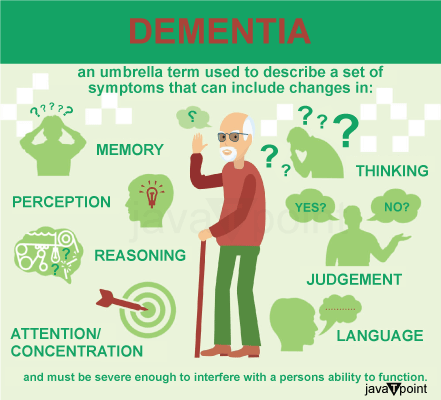
However, Alzheimer's disease, a neurodegenerative ailment, is the most prevalent cause. The Fifth Edition of the Diagnostic and Statistical Manual of Mental Disorders (DSM-5) reclassifies dementia as a moderate or significant neurocognitive disease with different degrees of severity and several causal subgroups. Dementia is also classified as a neurocognitive disorder (NCD) by the International Classification of Diseases (ICD-11). Dementia is classified as an acquired brain condition and is distinguished from neurodevelopmental diseases by a deterioration in cognitive function. Dementia is also described as a spectrum of disorders, with causative subtypes of dementia based on a known disorder, such as Parkinson's disease for Parkinson's disease dementia, Huntington's disease for Huntington's disease dementia, vascular disease for vascular dementia, HIV infection for HIV dementia, frontotemporal lobar degeneration for frontotemporal dementia, or Lewy body disease for dementia with Lewy bodies, and prion diseases. Subtypes of neurodegenerative dementias, such as synucleinopathies and tauopathies, may also be based on the pathology of misfolded proteins. Mixed dementia is the presence of more than one form of dementia. Many neurocognitive disorders can be caused by another medical condition or disorder, such as brain tumors and subdural hematomas; endocrine disorders like hypothyroidism and hypoglycemia; nutritional deficiencies like thiamine and niacin; infections, immune disorders, liver or kidney failure; metabolic disorders like Kufs disease and some leukodystrophies, and neurological disorders like epilepsy and multiple sclerosis. Some neurocognitive abnormalities may improve with medical condition therapy. The diagnosis is generally made based on the patient's medical history and cognitive tests with imaging. Blood tests may be performed to rule out other potentially reversible reasons, such as hypothyroidism (an underactive thyroid), and define the dementia subtype. The Mini-Mental State Examination is a regularly used cognitive exam. Aging is the most significant risk factor for acquiring dementia, although dementia is not a natural part of aging. Many adults beyond the age of 90 exhibit no indications of dementia. Several dementia risk factors, such as smoking and obesity, may be avoided by lifestyle adjustments. Screening the broader elderly population for the condition does not affect the result. Dementia is now the sixth greatest cause of mortality worldwide, with 10 million new cases diagnosed yearly (one every three seconds). Dementia has no recognized treatment. Donepezil, an acetylcholinesterase inhibitor, is often used and may be effective in mild to severe disorders. However, the total advantage may be insignificant. Several strategies may help persons with dementia and their carers live better lives. Cognitive and behavioral therapies may be useful in treating depression-related symptoms. 4. EpilepsyEpilepsy is a spectrum of noncommunicable neurological illnesses characterized by repeated epileptic episodes. An epileptic seizure is the clinical manifestation of an aberrant, excessive, purposeless, and synchronized electrical discharge in brain cells called neurons. Epilepsy is defined by the occurrence of two or more spontaneous seizures. The occurrence of merely one seizure may justify the criteria (established by the International League Against Epilepsy) in a more clinical context when recurrence may be predicted. Epileptic seizures may range from short and practically unnoticeable durations to extended periods of intense shaking caused by aberrant electrical activity in the brain. These episodes may cause physical harm, either directly, such as broken bones, or indirectly, by creating accidents. Seizures in epilepsy tend to reoccur and may have no immediate underlying cause. Isolated seizures caused by a particular cause, such as poisoning, are not considered epilepsy. Due to the frightening nature of their symptoms, people with epilepsy may be treated differently in different parts of the globe and face differing degrees of societal stigma. 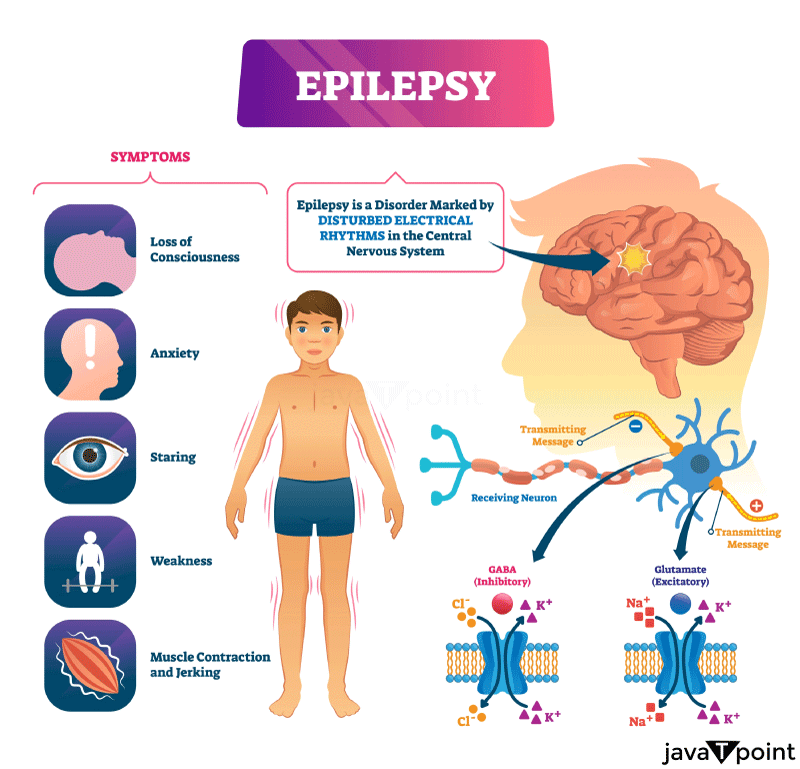
The basic mechanism of an epileptic seizure is excessive and aberrant neuronal activity in the brain's cortex, which may be seen in an individual's electroencephalogram (EEG). The cause of most instances of epilepsy is unclear (cryptogenic); however, some cases arise due to brain damage, stroke, brain tumors, infections of the brain, or birth abnormalities via a process known as epileptogenesis. Only a tiny percentage of cases are directly connected to known genetic alterations. The diagnosis entails ruling out other illnesses that may produce similar symptoms, such as fainting, and evaluating if another cause of seizures, such as alcohol withdrawal or electrolyte abnormalities, is present. This may be accomplished partly by imaging the brain and doing blood tests. An EEG may typically confirm epilepsy, although a normal test does not rule it out. Epilepsy caused by other conditions may be prevented. Seizures may be controlled with medicine in around 69% of instances; affordable anti-seizure drugs are often accessible. Surgery, neurostimulation, or dietary modifications may be explored in patients whose seizures do not respond to medication. Not all instances of epilepsy are permanent, and many individuals recover to the point where medication is no longer required. By 2020, around 50 million individuals will have epilepsy. Nearly 80% of instances occur in underdeveloped countries. It led to 125,000 fatalities in 2015, an increase from 112,000 in 1990. Epilepsy is more frequent in elderly adults. In the industrialized world, the start of new cases is more common among neonates and older people. Due to disparities in the frequency of the underlying causes, onset is more likely at the extremes of age in the developing world - in younger children, older children, and young adults. By age 80, around 5-10% of persons will experience an unprovoked seizure, with the likelihood of a second seizure increasing to between 40% and 50%. Many parts of the globe ban or prohibit people with epilepsy from driving. Epilepsy comes from the Greek phrase "to seize, possess, or afflict." 5. Cerebral Palsy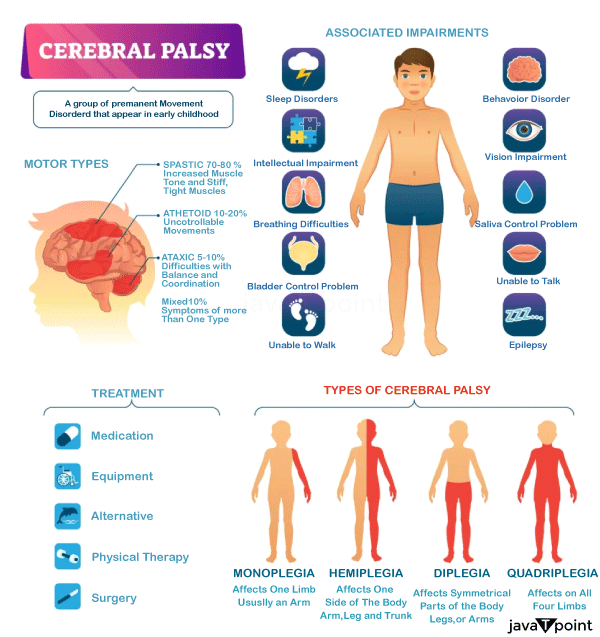
Cerebral palsy (CP) is a collection of mobility impairments manifesting in infancy. Poor coordination, tight muscles, weak muscles, and tremors are some of the signs and symptoms that individuals experience. There might be issues with feeling, vision, hearing, or speech. Babies with cerebral palsy often do not roll over, sit, crawl, or walk as soon as other children their age. Seizures and issues with thinking or reasoning are two more symptoms that affect roughly one-third of persons with CP. While symptoms may become more obvious in the first few years of life, fundamental issues may not worsen. Cerebral palsy is caused by faulty development or injury to brain regions that govern movement, balance, and posture. The difficulties often arise during pregnancy, although they may develop after labor or immediately after birth. The reason is often unknown. Preterm birth, having a twin, certain diseases such as toxoplasmosis or rubella, methylmercury exposure during pregnancy, a difficult delivery, and brain trauma during the first few years of life are also risk factors. A hereditary genetic etiology is thought to be responsible for around 2% of instances. Based on the particular challenges encountered, a variety of sub-types are identified. Spastic cerebral palsy, for example, is characterized by rigid muscles, ataxic cerebral palsy by poor coordination in locomotion, and dyskinetic cerebral palsy by writhing motions. The development of the kid through time is used to make a diagnosis. Other probable reasons may be ruled out using blood testing and medical imaging. Some causes of CP are preventable through maternal immunization and efforts to minimize head injuries in children, such as increased safety. Although there is no cure for CP, supportive therapy, medicine, and surgery may benefit many people. Physical therapy, occupational therapy, and speech therapy may all be included. Diazepam, baclofen, and botulinum toxin are some medications that can assist in relaxing stiff muscles. Muscle lengthening and nerve cutting may be performed during surgery. External braces, Lycra splints, and other assistive equipment can often help with movement. With the right therapy, some affected children can enjoy near-normal adult lives. Alternative medications are widely utilized, but there is little proof to back them up. The most prevalent mobility disability in children is cerebral palsy. It affects roughly 2.1 out of every 1,000 live births. Cerebral palsy has been chronicled throughout history, with the earliest known descriptions appearing in Hippocrates' writings in the fifth century BCE. William John Little conducted extensive research on the disorder in the nineteenth century, and spastic diplegia was dubbed "Little's disease" after him. The term "cerebral palsy" was coined by William Osler from the German zerebrale Kinderl�hmung (cerebral child-paralysis). Various potential treatments, including stem cell therapy, are being investigated. More study is needed to discover whether it is effective and safe. 6. Parkinson's DiseaseParkinson's disease (PD), sometimes known as Parkinson's disease, is a chronic degenerative central nervous system ailment that primarily affects the motor system. Symptoms normally appear gradually, and non-motor symptoms become more common as the disease progresses. Tremor, rigidity, slow movement, and trouble walking are early signs. Problems with cognition, behavior, sleep, and sensory systems are also possible. Parkinson's disease dementia grows common as the condition progresses. The disease's motor symptoms are caused by the loss of nerve cells in the substantia nigra, a midbrain area that feeds dopamine to the basal ganglia. The aggregation of the protein alpha-synuclein into Lewy bodies within neurons is thought to be the cause of this cell death. The main motor symptoms are called Parkinsonism or Parkinsonian condition. 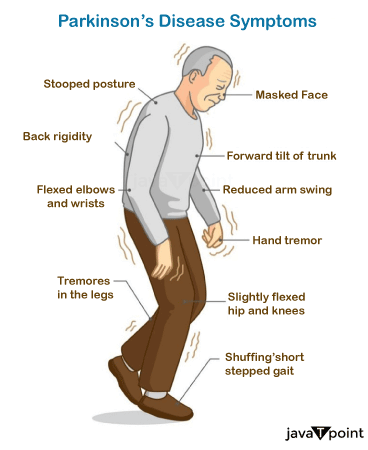
The etiology of Parkinson's disease is unknown. However, a mix of hereditary and environmental factors is thought to have a role. Those with a sick family member are more likely to have the condition, as specific genes are known to be inheritable risk factors. Environmental concerns include pesticide exposure and prior head injuries; trichloroethylene exposure is also implicated. Caffeine and nicotine, on the other hand, appear to be protective. Complaints are used to diagnose, with motor complaints being the most common. Neuroimaging (magnetic resonance imaging or imaging to look at dopamine neuronal dysfunction, often known as a DaT scan) is used to rule out other disorders. Parkinson's disease typically affects adults over 60, with approximately 1% impacted. Males are afflicted at about a 3:2 ratio as compared to females. When it occurs in people under the age of 50, it is referred to as early-onset Parkinson's disease. By 2015, PD had impacted 6.2 million people and claimed the lives of approximately 117,400 people worldwide. The number of people over fifty with Parkinson's disease is anticipated to increase by 2030. Following a diagnosis, the average life expectancy is 7-15 years. There is no known cure for Parkinson's; treatment seeks to alleviate the symptoms. Typically, the first line of treatment is levodopa (L-DOPA), MAO-B inhibitors, or dopamine agonists. These drugs become less helpful as the condition progresses, causing involuntary muscle spasms as a side effect. Medication may be administered in conjunction at that time, and doses may be raised. Diet and certain types of therapy have proven some efficacy in alleviating symptoms. In cases where medicines are inadequate, surgery to implant microelectrodes for deep brain stimulation has been utilized to alleviate severe motor symptoms. The evidence for treatments for non-movement-related PD symptoms, such as sleep disorders and emotional problems, is weaker. The sickness is named after English doctor James Parkinson, who first described the condition in 1817 in An Essay on the Shaking Palsy. Public awareness campaigns include World Parkinson's Day (April 11th, James Parkinson's birthday) and the usage of a red tulip as the disease's symbol. People with Parkinson's disease who have raised public awareness include boxer Muhammad Ali, comedian Billy Connolly, actor Michael J. Fox, Olympic cyclist Davis Phinney, and actor Alan Alda. 7. Migraine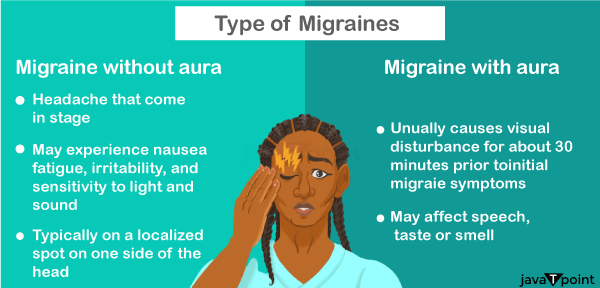
Migraine is a complicated neurological illness affected by genetics that is characterized by bouts of moderate-to-severe headache, most typically unilateral, and often accompanied by nausea and light and sound sensitivity. Other distinguishing symptoms include nausea, vomiting, cognitive impairment, allodynia, and dizziness. Another differentiating aspect is a worsening of headache symptoms with physical exercise. Aura is a premonitory time of sensory disruption largely acknowledged to be induced by cortical spreading depression before the outset of a migraine episode that affects up to one-third of migraine patients. Migraine is a very heterogeneous neurological illness in its clinical presentation. It is best considered a spectrum disease rather than a discrete clinical entity while predominantly regarded as a headache condition. Disease load might vary from incidental to chronic. Migraine is thought to be caused by a combination of genetic and environmental factors that alter the excitation and inhibition of nerve cells in the brain. A previous "vascular theory" proposed that migraine headache is caused by vasodilation and aura by vasoconstriction. However, this process has been proven false. According to current thinking, several fundamental neuronal deficits cause a cascade of intracranial and extracranial alterations, resulting in migraine symptomatology. The first line of defense is basic pain medicine such as ibuprofen and paracetamol (acetaminophen) for headaches, nausea medication, and avoidance of triggers. Specific drugs, such as triptans or ergotamines, may be utilized in patients who do not respond to ordinary pain relievers. Caffeine, when used in conjunction with other analgesics, is safe and effective in treating acute migraine. Migraine affects around 15% of the global population. Migraines were the third-most common condition in the world, according to the Global Burden of Disease Study, which was done in 2010. It usually begins throughout adolescence and becomes worse during middle age. It was one of the leading causes of disability in 2016. The Ebers Papyrus, written circa 1500 BCE in ancient Egypt, has an early description compatible with migraines. Migraine is derived from the Greek phrase "pain in half of the head." 8. Multiple SclerosisMultiple sclerosis (MS) is the most prevalent demyelinating disease, characterized by damage to the insulating coverings of nerve cells in the brain and spinal cord. This injury interferes with the capacity of portions of the nervous system to transfer information, resulting in various indications and symptoms, including physical, mental, and even psychiatric issues. Symptoms may include double vision, eyesight loss, muscular weakness, and sensory or coordination problems. MS manifests in various ways, with new symptoms appearing in solitary bouts (relapsing forms) or gradually (progressive forms). In relapsing MS, symptoms may resolve entirely between episodes, but certain chronic neurological abnormalities commonly persist, particularly as the illness progresses. While the etiology is unknown, the underlying process is assumed to be either immune system damage or failure of myelin-producing cells. Genetics and environmental factors, such as viral infections, have been proposed as possible causes. MS is often diagnosed based on the presence of symptoms and the findings of supportive medical testing. There is no known cure for multiple sclerosis. Treatments aim to enhance function after an assault and to avoid future attacks. Physical and occupational therapy may help patients regain their capacity to operate. Despite a lack of proof of effectiveness, many individuals seek alternative therapies. Long-term results are difficult to predict; better outcomes are more common among women, those with the condition early in life, those with a relapsing course, and those with few episodes at first. Multiple sclerosis is the most frequent immune-mediated central nervous system illness. In 2022, about one million individuals will have MS in the United States, and around 2.8 million people will be afflicted worldwide, with rates varying greatly among areas and demographics. The condition generally appears between the ages of 20 and 50, affecting women twice as often as males. Jean-Martin Charcot, a French neurologist, initially characterized MS in 1868. The term "multiple sclerosis" is an abbreviation for multiple cerebrospinal sclerosis, which refers to the accumulation of glial scars (or sclerae - basically plaques or lesions) on the white matter of the brain and spinal cord.
Next TopicBrain Fever Symptoms
|
 For Videos Join Our Youtube Channel: Join Now
For Videos Join Our Youtube Channel: Join Now
Feedback
- Send your Feedback to [email protected]
Help Others, Please Share









